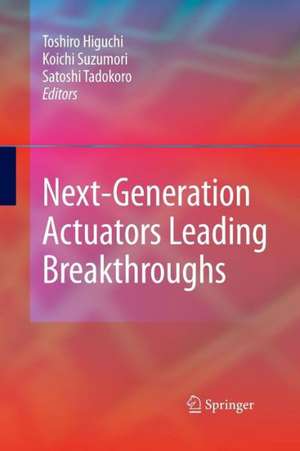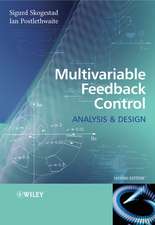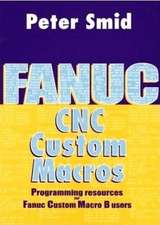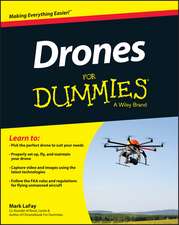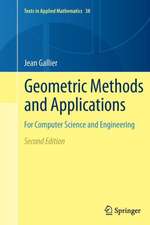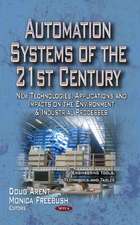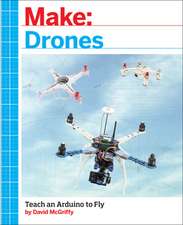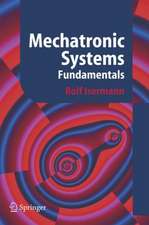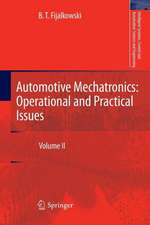Next-Generation Actuators Leading Breakthroughs
Editat de Toshiro Higuchi, Koichi Suzumori, Satoshi Tadokoroen Limba Engleză Paperback – 12 dec 2014
Since the realization of next-generation actuators requires an interdisciplinary approach, the research has been organized according to a broad technological perspective that consists of: actuators for small motion of nano-meters, small-size actuators of micro-meters structures, intelligent actuators for functional motions, power actuators for large force/torque and actuators for special environments.
Next-Generation Actuators Leading Breakthroughs also deals with common fundamental technologies for these actuators, such as intelligent materials, machining processes, control technologies, evaluation methods, and system integration. It provides cutting-edge research for researchers, postgraduates, and practitioners in mechanical, electrical, and materials industries.
| Toate formatele și edițiile | Preț | Express |
|---|---|---|
| Paperback (1) | 952.40 lei 6-8 săpt. | |
| SPRINGER LONDON – 12 dec 2014 | 952.40 lei 6-8 săpt. | |
| Hardback (1) | 960.78 lei 6-8 săpt. | |
| SPRINGER LONDON – 16 dec 2009 | 960.78 lei 6-8 săpt. |
Preț: 952.40 lei
Preț vechi: 1161.47 lei
-18% Nou
Puncte Express: 1429
Preț estimativ în valută:
182.26€ • 197.91$ • 153.10£
182.26€ • 197.91$ • 153.10£
Carte tipărită la comandă
Livrare economică 22 aprilie-06 mai
Preluare comenzi: 021 569.72.76
Specificații
ISBN-13: 9781447159704
ISBN-10: 1447159705
Pagini: 464
Ilustrații: XXII, 438 p.
Dimensiuni: 155 x 235 x 24 mm
Greutate: 0.64 kg
Ediția:2010
Editura: SPRINGER LONDON
Colecția Springer
Locul publicării:London, United Kingdom
ISBN-10: 1447159705
Pagini: 464
Ilustrații: XXII, 438 p.
Dimensiuni: 155 x 235 x 24 mm
Greutate: 0.64 kg
Ediția:2010
Editura: SPRINGER LONDON
Colecția Springer
Locul publicării:London, United Kingdom
Public țintă
ResearchDescriere
Actuators, which move and manipulate objects, are the key technological components for all modern science and technologies. The advent of new, outstanding actuators will bring innovation to a range of different areas – such as basic science, industry, medicine, welfare, and the global environment – and in this way will provide us with a better quality of life.
Next-Generation Actuators Leading Breakthroughs is the proceedings of the final symposium of MEXT Grant-in-Aid for Scientific Research on Priority Areas: Next-Generation Actuators Leading Breakthroughs, held in January 2010.
This project pursues the realization of next-generation actuators and accumulates the common basic technologies for actuators, with a view to possible future applications. Since the realization of next-generation actuators requires an interdisciplinary approach, the research has been organized according to a broad technological perspective that consists of:
• actuators for small motion of nano-meters;
• small-size actuators of micro-meters structures;
• intelligent actuators for functional motions;
• power actuators for large force/torque; and
• actuators for special environments.
Next-Generation Actuators Leading Breakthroughs also deals with common fundamental technologies for these actuators, such as intelligent materials, machining processes, control technologies, evaluation methods, and system integration. It provides cutting-edge research for researchers, postgraduates, and practitioners in mechanical, electrical, and materials industries.
Next-Generation Actuators Leading Breakthroughs is the proceedings of the final symposium of MEXT Grant-in-Aid for Scientific Research on Priority Areas: Next-Generation Actuators Leading Breakthroughs, held in January 2010.
This project pursues the realization of next-generation actuators and accumulates the common basic technologies for actuators, with a view to possible future applications. Since the realization of next-generation actuators requires an interdisciplinary approach, the research has been organized according to a broad technological perspective that consists of:
• actuators for small motion of nano-meters;
• small-size actuators of micro-meters structures;
• intelligent actuators for functional motions;
• power actuators for large force/torque; and
• actuators for special environments.
Next-Generation Actuators Leading Breakthroughs also deals with common fundamental technologies for these actuators, such as intelligent materials, machining processes, control technologies, evaluation methods, and system integration. It provides cutting-edge research for researchers, postgraduates, and practitioners in mechanical, electrical, and materials industries.
Cuprins
Next-Generation Actuators.- Surface Acoustic Wave Motor Modeling and Motion Control.- AZARASHI (Seal) Mechanism for Meso/Micro/Nano Manipulators.- Disturbance Observer Design Based on Frequency Domain.- Development of High-Speed Actuator for Scanning Probe Microscopy.- PZT Driven Micro XY Stage.- Precise Position Stages Using Pneumatically Driven Bellows Actuator and Cylinder Equipped with Air Bearings.- Development of a New Nano-Micro Solid Processing Technology Based on a LIGA Process and Next-Generation Microactuators.- New Microactuators Using Functional Floods.- Two-Axial Piezoelectric Actuator and Its Motion Control Toward Development of a Tactile Display.- High-Performance Electrostatic Micromirrors.- Non-Contact On-Chip Manipulation of 3-D Microtools and Its Applications.- Shape Memory Piezoelectric Actuator and Various Memories in Ferroelectric Materials.- Design and Fabrication of Micro Pump for Functional Fluid Power Actuation System.- Intellignet Actuators for Mechatronics with Multi-Degrees of Freedom. - Actuation of Long Flexible Cables Using Ciliary Vibration Drive.- Micro Cilium Actuators in Group.- Novel Thin-Type High-Speed Ultrasonic Motors and Gyro-Moment Motors.- Biochemical Pump with Enzymatic Reaction.- Domain Wall Engineering in Lead-Free Piezoelectric Materials and Their Enhanced Piezoelectricities. IPMC Actuator.- Pneumatic Rubber Artificial Muscles and Application to Welfare Robotics.- Dynamic Characteristics of Ultrasonic Motors.- Actuator with Multi Degrees of Freedom.- Segment-Structured Diamond-Like Carbon Films Application to Friction Drive of Surface Acoustic Wave Linear Motor.- Mechanism of Electroactive Polymer Actuator.- Development of a Polymer Actuator Utilizing Ion-Gel as Electrolyte.- Compact MR Fluid Actuator for Human Friendly System.- Development of Actuator Utilizing Hydrogen Storage Alloys.- Development of New Actuators for Special Environment.- Applications of Electrostatic Actuators within Special Environments.- Micro Actuator System for Narrow Spaces Under Specific Environment.- Development of Ultrasonic Micro Motor with a Coil Type Stator.- Self-Running Non-Contact Ultrasonically Levitated Stage.- Development of Shape Memory Actuator for Cryogenic Application.- Actuators for Special Environments.
Notă biografică
Toshiro Higuchi is a professor at the Department of Precision Machinery Engineering at the University of Tokyo, Japan. His research interests include mechatronics; magnetic bearings; electrostatic actuators; MEMS; robotics; and manufacturing.
Koichi Suzumori has been a professor at Okayama University, Japan, since 2001. He received his doctoral degree from Yokohama National University, and worked for Toshiba R&D Center and Micromachine Centre, Tokyo, before taking up his current position.
Satoshi Tadokoro currently works for the Graduate School of Information Sciences at Tohoku University, Japan. His areas of research include intelligent mechanics/mechanical systems; perception information processing/intelligent robotics and; design engineering and machine functional elements/tribology.
Koichi Suzumori has been a professor at Okayama University, Japan, since 2001. He received his doctoral degree from Yokohama National University, and worked for Toshiba R&D Center and Micromachine Centre, Tokyo, before taking up his current position.
Satoshi Tadokoro currently works for the Graduate School of Information Sciences at Tohoku University, Japan. His areas of research include intelligent mechanics/mechanical systems; perception information processing/intelligent robotics and; design engineering and machine functional elements/tribology.
Textul de pe ultima copertă
Actuators, which move and manipulate objects, are the key technological components for all modern science and technologies. The advent of new, outstanding actuators will bring innovation to a range of different areas – such as basic science, industry, medicine, welfare, and the global environment – and in this way will provide us with a better quality of life.
Next-Generation Actuators Leading Breakthroughs is the proceedings of the final symposium of MEXT Grant-in-Aid for Scientific Research on Priority Areas: Next-Generation Actuators Leading Breakthroughs, held in January 2010.
This project pursues the realization of next-generation actuators and accumulates the common basic technologies for actuators, with a view to possible future applications. Since the realization of next-generation actuators requires an interdisciplinary approach, the research has been organized according to a broad technological perspective that consists of:
• actuators for small motion of nano-meters;
• small-size actuators of micro-meters structures;
• intelligent actuators for functional motions;
• power actuators for large force/torque; and
• actuators for special environments.
Next-Generation Actuators Leading Breakthroughs also deals with common fundamental technologies for these actuators, such as intelligent materials, machining processes, control technologies, evaluation methods, and system integration. It provides cutting-edge research for researchers, postgraduates, and practitioners in mechanical, electrical, and materials industries.
Next-Generation Actuators Leading Breakthroughs is the proceedings of the final symposium of MEXT Grant-in-Aid for Scientific Research on Priority Areas: Next-Generation Actuators Leading Breakthroughs, held in January 2010.
This project pursues the realization of next-generation actuators and accumulates the common basic technologies for actuators, with a view to possible future applications. Since the realization of next-generation actuators requires an interdisciplinary approach, the research has been organized according to a broad technological perspective that consists of:
• actuators for small motion of nano-meters;
• small-size actuators of micro-meters structures;
• intelligent actuators for functional motions;
• power actuators for large force/torque; and
• actuators for special environments.
Next-Generation Actuators Leading Breakthroughs also deals with common fundamental technologies for these actuators, such as intelligent materials, machining processes, control technologies, evaluation methods, and system integration. It provides cutting-edge research for researchers, postgraduates, and practitioners in mechanical, electrical, and materials industries.
Caracteristici
Presents the latest R D in the MEXT Grant-in-Aid for Scientific Research on Priority Areas, No. 438, Next-Generation Actuators Leading Breakthroughs (2004-2009, PI: Toshiro Higuchi, University of Tokyo)
Maintains a broad technological perspective
Includes supplementary material: sn.pub/extras
Maintains a broad technological perspective
Includes supplementary material: sn.pub/extras
